#pedro iv de aragón
Explore tagged Tumblr posts
Text
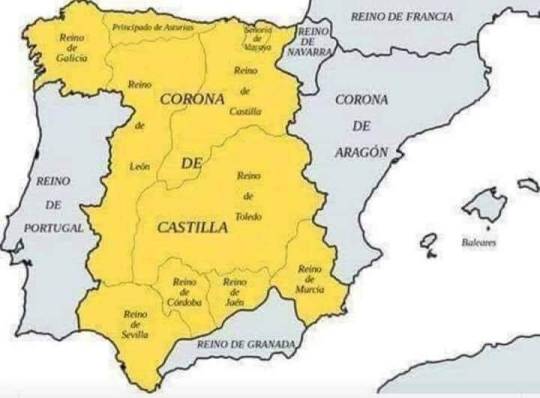
Los 8 datos que explican porqué el reino de Cataluña nunca existió (y los nacionalistas ocultan)
CATALUÑA NUNCA EXISTIÓ
En la idea de construir una ‘nación catalana‘, la formación de la Corona de Aragón deja en evidencia el relato de una nación catalana milenaria (o la corona catalanoaragonesa) por haber sido siempre fruto del destino de los reyes aragoneses. Y nunca tuvieron un carácter independiente en sus designios políticos.
Las órbitas independentistas siempre han intentado tergiversar la historia de la Corona de Aragón con hechos puestos en duda o con un gasto millonario en subvencionar a asociaciones que difundan las manipulaciones de los intereses políticos del nacionalismo. En concreto, hay 8 datos que el independentismo intenta derribar para formar su idea nacionalista pero que explican porqué el reino de Cataluña nunca existió.
Aragón será el «cabo principal de nuestra alteza» y «nombre y título nuestro principal», en palabras de Jaime I y de Pedro IV: los Aragón y los miembros de su familia se denominan de modo constante y único «Aragón».
SEÑERA
Con la constitución de Reino de Aragón tras incorporarse la casa de Barcelona, en ningún momento se pierde el emblema de la familia: las cuatro barras rojas sobre un fondo de oro que significa el ‘señal real de Aragón’. Un emblema que pasará a ser el de muchos de sus territorios. Es de la frase ‘señal real de Aragón’ de donde procede el término «senyera» o señera usado en Cataluña, Valencia y otros lugares de la antigua Corona de Aragón.
¿SANT JORDI O SAN JORGE?
Fue en la ciudad de Calatayud en 1461 donde, por orden de Juan II, se celebran las Cortes de Aragón que establecen la festividad del día de San Jorge el 23 de abril. Según consta en el diario de sesiones, será un día «inviolablemente, perpetua, guardada, observada y celebrada solemnemente» en todo el Reino de Aragón. Lo que incluye los territorios que de éste dependen, como Cataluña.
ESCUDO DE ARAGÓN
El escudo de Aragón, tal y como se conoce actualmente, se configuró en 1499. Está formado por cuatro emblemas o cuarteles: el Árbol de Sobrarbe, la Cruz de Íñigo Arista, la Cruz de Alcoraz y, por último, los cuatro palos gules de las barras de Aragón iguales entre sí. Una corona colocada en la parte superior del espacio que ocupan los cuatro emblemas mismos completa así la insignia del escudo de Aragón.
Las Barras de Aragón (cuarto cuartel) son un símbolo común a otras regiones como Cataluña, Baleares o Comunidad Valenciana.
PRÍNCIPE DE GERONA
El 21 de enero de 1351, Pedro IV creó el ducado de Gerona para afianzar la posición del heredero de la Corona aragonesa. Con las rentas de este ducado, se dotaba al recién nacido -su hijo Juan I- y automáticamente al príncipe heredero como garantía del estatus que le correspondía por nacimiento y lo situaba al frente de la jerarquía nobiliaria por encima de marqueses y condes.
DE CONDADO A SER PARTE DEL REINO
El matrimonio de Petronila, la hija del rey aragonés Ramiro II “el Monje”, con el duque Ramón Berenguer supuso la unión dinástica de los condados carolingios de Aragón, Sobrarbe y Ribagorza con la casa de Barcelona. De ahí fue cuando en 1035 se constituye el Reino de Aragón. Y en 1150 se termina convirtiendo en la Corona de Aragón.
ARAGONÉS
El termino aragonés siempre sirvió para designar a los naturales del Reino de Aragón o a los naturales de cualquiera de los reinos o principados comprendidos dentro de la Corona de Aragón. Incluido también a aquellos que vivían en el condado de Barcelona o en los Reinos de Valencia o Mallorca.
El término aragonés estuvo presente durante más de 300 años en todo el mar Mediterráneo. Por ejemplo, cuando se avistaba un navío con la señal de Aragón o los documentos de la época que servían de crónicas del reino.
NOMBRES REALES
Los nombres dinásticos característicos de la Casa de Aragón son Pedro -cinco reyes- y Alfonso -con otros cinco monarcas-. Ramiro II llamó Petronila (femenino de Pedro) a su hija y heredera, que se desposó con Ramón Berenguer (conde de Barcelona), de cuyo matrimonio nació el rey Alfonso II, en recuerdo de Alfonso I el Batallador.
Los reyes de Aragón no se llamaron Ramón, ni Berenguer, ni Pere, ni Jaume, ni nombres propios del Condado de Barcelona. Todos los nombres eran de origen aragonés.
Grupo La Tarántula 🕷️
#historia#facts#palabras#citas#frases#textos#notas#escrituras#escritos#words#quotes#phrases#map#mapa#history#españa#spain#iberian peninsula#europe#poem#poetry#geography#reconquista#entity#memes#UFC#MMA#WWE#civilization#spiderman
13 notes
·
View notes
Text




IMAGENES Y DATOS INTERESANTES DEL DIA 13 DE ABRIL DE 2024
Día Internacional del Beso, Día de Concienciación de la Sarcoidosis, Día Mundial del Scrabble, Año Internacional de los Camélidos.
San Martín I.
Tal día como hoy en el año 2002
En Venezuela fracasa el golpe de Estado militar, que el día anterior ha colocado al empresario Pedro Carmona Estanga como presidente interino del país, restableciendo al depuesto Hugo Chávez en la presidencia. (Hace 22 años)
1975
Comienza una cruenta guerra civil en Líbano, entre cristianos y musulmanes, que durará 15 años y con intervenciones de Israel y Siria con intereses en la zona. (Hace 49 años)
1943
Coincidiendo con el 200 aniversario de su nacimiento, en Washington DC (EE.UU.), se inaugura el Thomas Jefferson Memorial. (Hace 81 años)
1941
Japón alcanza un pacto de neutralidad con la Unión Soviética durante la II Guerra Mundial. (Hace 83 años)
1813
José Gervasio Artigas, desde su campamento situado cerca del arroyo Ayuí Grande, a pocos kilómetros al norte de la actual ciudad entrerriana de Concordia (en la actual República Argentina), dicta y envía a Buenos Aires sus famosas "Instrucciones", un programa que representa una justa interpretación del movimiento revolucionario que dará la independencia a América en el que reclama la Declaración de Independencia del poder español, libertad civil y religiosa, organización política federativa, Estados autónomos, igualdad de las provincias a través de un pacto recíproco y, por último, que Buenos Aires no sea la sede del gobierno central. Los diplomas de los diputados orientales serán rechazados por la Asamblea, usando como argumento legal la nulidad de su elección. (Hace 211 años)
1742
En un concierto con fines caritativos y ante 700 personas se estrena en Dublín (Irlanda) "El Mesías", una meditación sobre la vida de Cristo, del gran compositor inglés, de origen alemán, Georg Friedrich Händel. (Hace 282 años)
1640
Por primera vez desde 1628, el rey Carlos I de Inglaterra convoca al Parlamento para que apruebe la financiación de la guerra contra los separatistas escoceses. Al existir insalvables contrastes entre la Corona y el Parlamento, Carlos I procede a su disolución. (Hace 384 años)
1598
El rey Enrique IV de Francia promulga el Edicto de Nantes, en Bretaña, mediante el que se reconoce el protestantismo como una religión y no como herejía y se concede un amplio grado de libertad religiosa a los hugonotes, terminando por tanto con las Guerras de Religión de Francia. Los católicos no lo reciben con agrado y el poder del Estado sale bastante reforzado. (Hace 426 años)
1534
En Londres, Inglaterra, el humanista y cardenal inglés Tomás Moro, autor del libro Utopía, se niega a firmar el acta que reconoce a Enrique VIII como jefe de la iglesia y a consentir su divorcio de Catalina de Aragón. Por ello será acusado de alta traición, encarcelado en la Torrre de Londres y decapitado un año más tarde. (Hace 490 años)
0 notes
Text
Petronila I de Aragón: La reina que unió Aragón y Cataluña
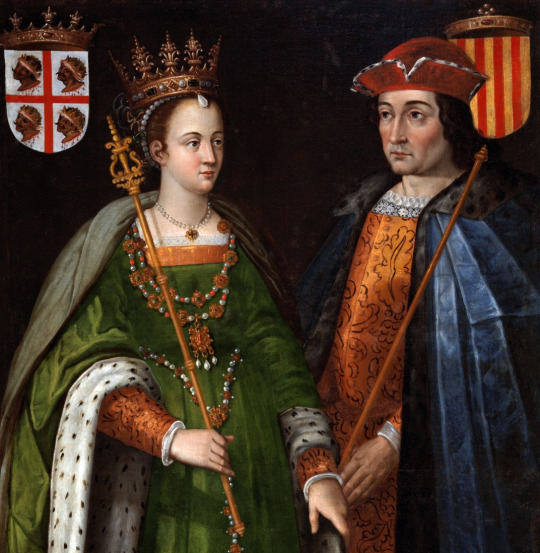
¿Sabías que Petronila I de Aragón fue la reina que unió los destinos de Aragón y Cataluña? Su matrimonio con el conde Ramón Berenguer IV dio origen a la Corona de Aragón, una de las potencias más influyentes de la Edad Media. Esta es su apasionante historia.
Petronila nació el 29 de junio de 1136 en Huesca, hija del rey Ramiro II el Monje y de Inés de Poitou. Su padre había abandonado su condición eclesiástica para asumir el trono tras la muerte de su hermano Alfonso I el Batallador, que no dejó descendencia. Sin embargo, Ramiro II no quería reinar, sino volver al monasterio. Por eso, cuando Petronila tenía solo un año, la comprometió con el conde de Barcelona, Ramón Berenguer IV, y le cedió todos sus derechos sobre el reino de Aragón. Así, Petronila se convirtió en la heredera de la corona aragonesa, y Ramón Berenguer en el príncipe consorte.
Petronila fue educada en la corte barcelonesa, donde aprendió las lenguas y las costumbres de su futuro esposo. El matrimonio se celebró en 1150, cuando Petronila tenía catorce años y Ramón Berenguer treinta y seis. A pesar de la diferencia de edad, se dice que se amaron y se respetaron mutuamente. Tuvieron cinco hijos: Pedro, Alfonso, Ramón, Dulce y Sancho.
Durante su matrimonio, Petronila y Ramón Berenguer gobernaron conjuntamente los territorios de Aragón y Cataluña, aunque él llevó el peso de la política y la guerra. Juntos, defendieron sus dominios de las amenazas de los reinos vecinos, especialmente de Castilla y Navarra, y expandieron sus fronteras hacia el sur, conquistando parte de Valencia y Murcia a los musulmanes.
Petronila y Ramón Berenguer también impulsaron el desarrollo cultural, económico y social de sus tierras, favoreciendo el comercio, las artes, las letras y las instituciones. Fueron protectores de monasterios, iglesias y hospitales, y promotores de la reforma gregoriana. Además, mantuvieron buenas relaciones con el papado y con otros reinos europeos, como Francia e Inglaterra.
La muerte de Ramón Berenguer en 1162 supuso un duro golpe para Petronila, que quedó viuda a los veintiséis años. Dos años después, en 1164, decidió abdicar en su hijo mayor, Alfonso, que se convirtió en el primer rey de la Corona de Aragón, con el título de Alfonso II. Petronila se retiró de la vida pública y se dedicó a la educación de sus hijos menores y a la oración. Murió en 1173, a los treinta y siete años, y fue enterrada junto a su esposo en el monasterio de Poblet.
Petronila de Aragón fue una mujer que vivió una vida extraordinaria, marcada por el amor, el poder y la fe. Su historia es una de las más importantes de la historia de España, y merece ser recordada.
#Historia#Aragón#Cataluña#MujeresEnLaHistoria#reinas
Recuerda que: Este post ha sido escrito con fines informativos y de entretenimiento. Se recomienda realizar investigaciones adicionales para obtener una visión completa de la historia de Petronila I de Aragón.
Las imágenes son solo ilustrativas no representa en si el personaje en la cual se hace mención.
0 notes
Text

«Juego de Tronos no es nada comparado con las intrigas y la violencia de la Castilla del siglo XIV.»
José Luis Corral
1312. Ríos de sangre corren por el reino de Castilla y León tras la muerte de Fernando IV, cuando su hijo y heredero, Alfonso XI, tiene apenas un año. Mientras nobles y miembros de la corte libran una terrible lucha por hacerse con el trono, solo María de Molina y Constanza de Portugal, abuela y madre de Alfonso, lo protegerán y urdirán una compleja trama de intrigas y alianzas para conservar la corona que todos ambicionan.
Esta novela da comienzo a una bilogía en la que el reputado medievalista y escritor José Luis Corral aborda los reinados de Alfonso XI el Justiciero, y el de su hijo Pedro I de Castilla el Cruel. Amores prohibidos, pactos envenenados, sed de justicia y hombres despiadados dan vida a esta narración fascinante.

Cuando Alfonso XI, Rey de Castilla y León, muere a causa de la peste negra durante el asedio a Gibraltar, el reino queda huérfano, con las fronteras amenazadas y las cosechas devastadas. Será entonces cuando su hijo Pedro, un joven de quince años con gran sed de poder, que ha vivido apartado y marginado de la corte, se coronará rey.
Empujado por las ansias de venganza de su madre, María de Portugal, y amenazado por la vil mirada de su hermano bastardo, Enrique de Trastámara, Pedro I provocará una oleada de violencia, odio y masacres que determinarían el destino de los reinos de Castilla y León, Portugal y Granada y de la Corona de Aragón. Su reinado continuaría las traiciones, las alianzas y las guerras, desatadas por la envidia, amores prohibidos, sexo e intereses ocultos que traspasaron los muros de palacio y marcaron para siempre esta época como una de las más sangrientas de nuestra Historia.
1 note
·
View note
Video
VIRGEN DE LA CUEVA SANTA Patrona de la Diócesis de Segorbe CASTELLON
VIRGEN DE LA CUEVA SANTA Patrona de la Diócesis de Segorbe - Castellón La Imagen de la Virgen de la Cueva Santa está moldeada sobre una piedra de yeso. Reproduce el rostro de María, un rostro amable y austero. Sus orígenes están unidos a la fundación de la Cartuja de Val de Crist, cercana al Santuario. Fundada por el Infante don Martín, hijo del rey de Aragón Pedro IV en 1383. Un monje de dicha Cartuja, fray Bonifacio Ferrer. Vicente Ferrer, movido por su intensa devoción a la Santísima Virgen. modeló la imagen. Esta imagen, repetida con profusión, se colocó a la entrada de las celdas de los monjes. Una de estas reproducciones llegó a manos de un pastor que la introdujo en lo más hondo de la cueva donde, con su baño, busca refugio en las noches y en las tormentas. A ella se confiaba y expresaba su devoción y veneración, y sus necesidades. Murió el pastor y quedó olvidada la imagen. En 1503 otro pastor, por revelación de la santísima Virgen, según la tradición, descubrió la Imagen en el fondo de la cueva. Dio a conocer el hallazgo y no se quedó en su devoción personal sino que la dio a conocer a amigos, familia y vecindario. Durante las guerras de Germanías, los fugitivos y expatriados buscaron refugio y protección en la Cueva Santa, alcanzando el favor de la Santísima Virgen. En 1574 los Jurados de Jérica desterraron del pueblo a Juan. Monserrate porque tenía la lepra, su mujer Isabel, lo llevó a la Cueva Santa. implorando a la Virgen María que lo curara, lavándose con el agua que manaba de la cueva sanó milagrosamente. Las visitas al Santuario se hicieron más frecuentes y numerosas desde Alcublas, Altura, Segorbe y de todas las poblaciones circundantes. A lo largo de los siglos sus devotos la han invocado en sus necesidades, alcanzando señalados favores de la Virgen Maria. Esta capilla ha sido erigida por la Cofradía de la Cueva Santa de la Ciudad de Valencia, constituida especialmente por vecinos de Altura, Alcublas y poblaciones cercanas al Santuario.
0 notes
Text





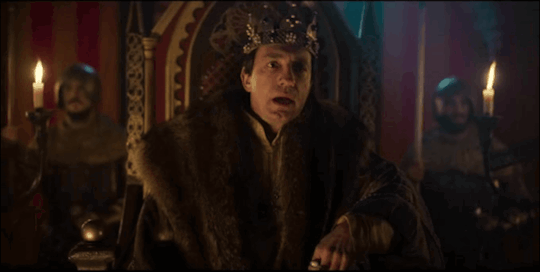

A guide through the monarchs of Aragon in La Catedral del mar & Los Herederos de la tierra
@asongofstarkandtargaryen
During the series the role of the members of the monarchy is secondary, but they are used to help to establish a concrete historical context and they're very determinant in the situation of the Puig and Entanyol families involving political estrategies of supporting this or that king, that gave them benefits or dacay (Arnau's rise with Pedro IV, Genís & Roger rise with Juan I and Martín I and Bernat with Fernando I). So, I wanted to make a recopilation of the monarchs shown during these series and their families.
House of Aragon/ House of Barcelona (descendants of the Jimena dinasty)
The Jimena dinasty is called like that because its origin was Jimeno "the Strong", grandfather of Eneko Arizta, and one of its branches was the Arista-Iñiga dinasty started by Eneko.
Eneko, his son García Iñiguez and his grandson Fortún Garcés were Lords of Pamplona, Fortún Garcés married Awriya bint Lubb ibn Musa (great-grandaughter of Musa the Great), and one of their daughters was Oneka Fortúnez, who married Abd Allah I of Cordoba (their son was Muhammad, who fathered the calipha Abd al-Rahman III with a basque woman called Muzna) and then Oneka married Aznar S��nchez de Larraún, and had a daughter with him, Toda Aznárez. Toda married Sancho Garcés I, the truly first king of Pamplona, was Sancho Garcés I (the first king of the Jimena dinasty).
Sancho Garcés III (992-1036) was king of Pamplona, Count of Aragon and king consort of Castile, whose bastard son with Sancha de Aibar, Ramiro I, inherited the counties of Aragon, Sobarbe and Ribagorza, and united them to form the kingdom of Aragon.
Then Petronila I (1136-1173), Ramiro I's great-grandaughter, married Ramón Berenguer IV count of Barcelona. Their son Alfonso II of Aragon was the first king of the Crown of Aragon and Pedro IV's great-great- great-grandfather.
In summary all the Aragonese monarchs are descedants of Eneko Arizta (and that's the way we can link Irati with LCDM/LHDLT)
Pedro IV
Pedro IV of Aragon, II of Valencia and I of Mallorca (Balaguer, Lleida, Catalonia, September 5, 1319 - Barcelona, Catalonia, January 5, 1387), called "the Ceremonious" or the Punyalet ('the one with the dagger', due to a dagger he used to carry), son of Alfonso IV of Aragon and Teresa de Entenza.
King of Aragon, Valencia and Mallorca (1344-1387); Duke of Athens (1380-1387) and Neopatria (1377-1387); count of Barcelona (1336-1387) and of Ampurias (1386-1387).
In 1338 he married María de Navarra (1326-1347), daughter of Felipe III and Juana II of Navarra. Offspring:
Constanza (1343-1363), married in 1361 to Federico III of Sicily, and Juana (1344-1385), married in 1373 with Juan I de Ampurias.
In 1347 he married Leonor of Portugal (1328-1348), daughter of Alfonso IV of Portugal. She died the following year of the Black Death.
In 1349 he married Eleanor of Sicily (1325-1375), daughter of Pedro II of Sicily. Offspring:
Juan I (1350-1396), Martin I (1356-1410) and Leonor (1358-1382), married to Juan I of Castile. Leonor was the mother of Fernando I of Aragon.
In 1377 he married Sibila de Fortiá, daughter of the Empordà nobleman Berenguer de Fortiá. Offspring:
Isabel (1380–1424), who married Jaime II of Urgel, future suitor for the aragonese crown.
During his reign the Aragonese expansionism in the Mediterranean continued, focused on southern Italy and Greece.
Although he was ally of Alfonso XI, Pedro IV had a great rivalry with his son Pedro I of Castile and fought against him in some conflicts, like the War of the two Pedros (1356-1369) and the first Castilian Civil War (1351-1369), in which Pedro I was supported by Pedro I of Portugal (one of his bastard sons, Juan I of Portugal, was the founder and first king of the Avis dinasty) and Muhammad V of Granada, and Pedro IV supported the bastard children of Alfonso XI with his lover Leonor de Guzmán (Pedro de Aguilar, Sancho Alfonso, Fadrique Alfonso, Enrique II of Castile, Fernando Alfonso, Tello, Juan Alfonso, Juana Alfonso, Sancho and Pedro Alfonso), who started several revolts against Pedro I of Castile. The wars ended when Enrique killed Pedro I, and he became the first king of Castile of the Trastamara dinasty.
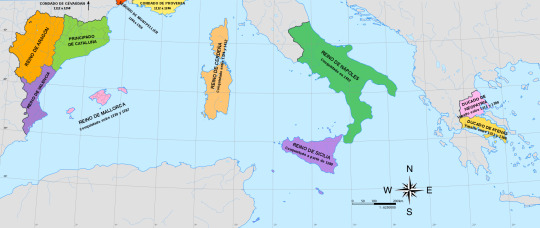
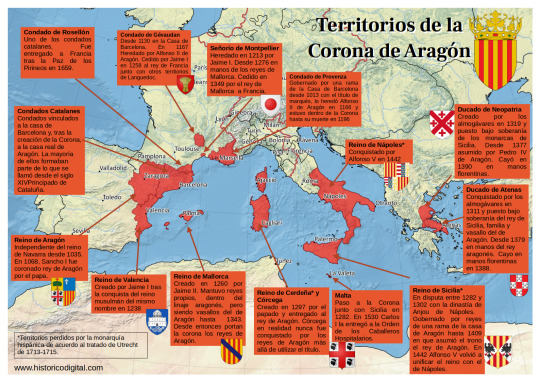
Sibila de Fortiá
Sibila de Fortiá (Fortiá, Girona, Catalonia, 1350 - Barcelona, Catalonia, 1406), queen consort of the Crown of Aragon (1377-1387). She was the daughter of Berenguer de Fortiá and his wife Francesca de Vilamarí. In 1371 she married for the first time Artal de Foces, an Aragonese nobleman, whom she widowed in 1374, and then she the lover of Pedro IV and had a daughter with him, Isabel.Pedro and Sibila married in 1377. After the wedding, Pedro surrounded himself with Empordà nobles as well as Sibila's relatives.
Pedro IV was very ill at the end of the year 1386, and Sibila, fearful of the wrath of the future King Juan, fled to the castle of San Martín de Sarroca (Barcelona), which belonged to her brother Bernat de Fortiá. There she was imprisoned by Juan I, who treated her harshly, accusing her of abandoning the king on his deathbed and of several robberies in the palace. She was confined in the castle of Moncada (Barcelona) until she renounced his property granted by the king. Finally, Sibila retired to the convent of San Francisco in Barcelona, where she died in 1406.
Juan I
Juan I of Aragon, called the Hunter or the Lover of All Kindness (Perpignan, Occitania, France, 1350 - Torroella de Montgrí, Girona, Catalonia, 1396), King of Aragon, Valencia, Mallorca, Sardinia and Corsica, and Count of Barcelona, Roussillon and Cerdanya ( 1387-1396). Son of Pedro IV and Leonor of Sicily.
His first marriage was with Marta de Armagnac (1347-1378), daughter of Count Juan I de Armagnac. With whom he had: Jaime (1374), Juana, (1375-1407) who married Mateo, Count of Foix. After the death of her father, she claimed the throne with her husband, but they were defeated; Juan (1376), Alfonso (1377) and Leonor (1378).
Widowed, Juan married Violante de Bar (1365-1431), daughter of Robert I, Duke of Bar. Offspring:
Jaime Duke of Girona (1382-1388), Yolanda, who married Louis II of Anjou, titular king of Naples. Their son, Luis III, claimed the throne after the death of Martín I, in the engagement of Caspe; Fernando Duke of Girona (1389), Antonia (1391-1392), Juan Duke of Girona (1392-1396), Eleanor (1393), Pedro Duke of Girona (1394) and Juan (1396)
Martin I
Martin I of Aragon, also called the Human or the Old (Girona, July 29, 1356-Barcelona, May 31, 1410), was king of Aragon, of Valencia, of Majorca, of Sardinia and count of Barcelona (1396-1420) and king of Sicily (1409-1410). Second son of Pedro IV of Aragon and his third wife Leonor of Sicily.
Martín was called "the Human" because of his great passion for the Humanities and books. The library of Martín I is the first that could be considered from Renaissance, if at that time in the history of the Iberian peninsula the term can already be used.
Martin married in 1372 with Maria de Luna, daughter of Lope, the first count of Luna, in 1374. From this union they were born:
Jaime (1378), Juan (1380) and Margarita (1388) and Martin I of Sicily "the Younger" (1376-1409), first husband of Blanca I of Navarra.
When Martin the Younger died, Martin married Margarita de Frades, although they left no issue.
His entire reign was marked by the Western Schism that divided Christianity since 1378. He was a supporter of the popes of Avignon (where he went the year of his coronation to swear allegiance to Benedict XIII "the Pope Luna", Pedro Martínez de Luna y Pérez de Gotor, with whom it seems that he came to establish a friendly relationship ), from whom he obtained support in his claims over the kingdom of Sicily against the Anjou, supporters of the popes of Rome. In 1400, he would marry his niece Yolanda to Louis II of Anjou in order to defuse tensions. He met in Avignon with the antipope Benedict XIII, Aragonese and a relative of the queen, with the intention of reaching a solution to the schism and, later, in 1403 he intervened militarily against the siege that Benedict suffered in his papal seat, rescuing him and welcoming him in Peñíscola .
House of Trastamara (the Aragonese branch)
Fernando I
Ferdinand I of Aragon (Medina del Campo, Valladolid, Castile and Leon, November 27, 1380-Igualada, April 2, 1416), also called Fernando de Trastámara and Fernando de Antequera, the Just and the Honest, was an infant of Castile, king of Aragon, Valencia, Mallorca, Sardinia, Count of Barcelona (1412-1416), and regent of Castile (1406-1415), during the minority of Juan II of Castile. Son of Juan I of Castile and Leonor of Aragon.
He was the first Aragonese monarch of the Castilian dynasty of the Trastámara, although he was of Aragonese origin on his mother's side.
He married Leonor de Alburquerque
Alfonso the Magnanimous (Medina del Campo, 1394-1458), king of Aragon, with the name of Alfonso V, and of Naples and Sicily, with the name of Alfonso I.
María de Aragón (Medina del Campo, 1396-1445), first wife of Juan II of Castile and mother of Enrique V of Castile
Juan II (Medina del Campo, 1397-1479), King of Aragon and King consort of Navarre.
Enrique (1400-Calatayud, 1445), II Duke of Villena, III Count of Alburquerque, Count of Ampurias, Grand Master of the Order of Santiago.
Leonor (1402-1445), who married Eduardo I of Portugal. Mother of Alfonso V of Portugal, Juana of Portugal (Enrique IV's second wife) and Leonor of Portugal, who married Frederick III of Habsburg (they were parents of emperor Maximilian I of Austria)
Pedro (1406-1438), IV Count of Alburquerque, Duke of Noto.
Sancho (1400-1416)
Alfonso V
Alfonso V of Aragon (Medina del Campo, 1396 – Naples, June 27, 1458), also called the Wise or the Magnanimous, king of Aragon, of Valencia, of Majorca, of Sicily, of Sardinia and Count of Barcelona (1426-1458); and King of Naples (1446-1458).
Alfonso V can be considered as a genuine prince of the Renaissance, since he developed an important cultural and literary patronage that earned him the nickname of the Wise and that would make Naples the main focus of the entry of Renaissance humanism in the sphere of the Crown of Aragon.
From his relationship with his lover Giraldona de Carlino, a napolitan noblewoman, he had three children:
Fernando (1423-1494), his successor in the kingdom of Naples under the name Fernando I.
Maria (1425-1449), married to Lionel, Marquis of Este and Duke of Ferrara.
Leonor, or Diana Eleonora (?-1450), married the nobleman Marino Marzano, Prince of Rossano.
Maria of Castile
María of Castile (Segovia, Castile and Leon, November 14, 1401-Valencia, October 4, 1458). Infanta of Castile, Princess of Asturias (1402-1405) and Queen of Aragon (1416-1458) for her marriage to Alfonso the Magnanimous. First daughter of Enrique III "the Mourner" and Catherine of Lancaster. Sister of Juan II of Castile, untie of Enrique IV and Isabel I.
The marriage between María and Alfonso is celebrated in the Cathedral of Valencia on October 12, 1415. The ceremony was officiated by the antipope Benedict XIII, who also granted the matrimonial dispensation for the wedding.
In 1420, when the king left for Naples for the first time, he left the government of his kingdoms in the hands of Maria as lieutenant general. The absence of the Magnanimous would last three years, during which María had to face the rapid deterioration of the economic situation in Catalonia, the territorial struggle with the Castilian Crown, as well as the conflicts of a social nature that shook her in different kingdoms. On his return to Aragon in 1423, Alfonso V began the war with Castile, along with his brother King Juan of Navarra. But her financial resources were exhausted and in 1429 Queen María had to act as a mediator between her husband and her brother, King Juan II of Castile, to put an end to the dispute. However, Alfonso's situation did not improve, due to the recession suffered by the Catalan economy and the social conflicts caused by it. The Courts of Barcelona in 1431 demanded from the king a series of measures to correct the enormous deficit of the Catalan treasury and trade. But Alfonso, fed up with these matters, returned to Italy and gave full powers to the queen as ruler of Aragon; he left the Iberian Peninsula forever on May 29, 1432. This marked Alfonso V's final break with the Crown of Aragon, which, however, he never renounced.
+ Bonus track (although he doesn't appear in this series)
Juan II
Juan II of Aragon and Navarra, the Great, or the Faithless according to the Catalan rebels who rose up against him (Medina del Campo, June 29, 1398-Barcelona, January 20, 1479) was Duke of Peñafiel, King of Navarre (1425-1479), King of Sicily (1458-1468) and King of Aragon, Mallorca, Valencia, Sardinia (1458-1479) and Count of Barcelona, son of Ferdinand I of Aragon and Leonor de Albuquerque.
From his first marriage to Blanca I of Navarra (daughter of Leonor of Castile and Carlos III of Navarra):
Carlos (1421-1461), Prince of Viana and Girona, Duke of Gandia and Montblanch, titular King of Navarra as Carlos IV (1441–1461), married Agnes of Cleves. He wrote the 'Chronicles of the Monarchs of Navarra', about the history of his antecessors, from Eneko Arizta in the 8th century up to the 15th century.
Juan (1423-1425)
Blanca of Navarra (1424-1464), first wife of Enrique IV of Castile
Leonor (1425-1479), married to Gastón IV de Foix, Queen of Navarre under the name of Leonor I.
From his second marriage to Juana Enríquez:
Leonor of Aragon (1448)
Fernando II (1452-1516), king iure uxoris of Castile (1474-1504) and then regent between 1507 and 1516, under the name of Fernando V due to his marriage to Isabel I, king of Sicily (as Fernando II, 1468-1516), Aragon and Sardinia (as Fernando II, 1479-1516), Naples (as Fernando III, 1504-1516), and from Navarra (as Fernando I, 1512-1516)
Juana (1455-1517), second wife of Fernando I of Naples. Her daughter Juana married Fernando II of Naples (Fernando I of Naples' grandson)
During his youth, Juan fought in the Castilian-Aragonese war (1429-30) and the Castilian Civil War (1437-1445) in the Aragonese team against Juan II of Castile, his son Enrique and the Constable Álvaro de Luna (favourite of Juan II), due to the Aragonese political influences in Castile and the full control that Álvaro de Luna had over Juan II of Castile that allowed him to become very powerful, so some members of the Castilian nobility wanted to remove Álvaro out of Juan II side because of that, and the Aragonese reacted to the anti-aragonese convictons of Álvaro.
Álvaro de Luna arranged a new marriage between Juan II of Castile and Isabel of Portugal (mother of Isabel I) in 1447. The constable intended with this dynastic alliance to strengthen the political ties that united Castile and Portugal against the common enemy: the Catalan-Aragonese Crown, but from 1449, Isabella of Portugal indirectly supported the maneuvers of the Great League of Nobles (allies of the Aragonese) formed against the constable. But it would not be until 1453 when Juan II of Castile, possibly tired of the continuous pressure from the aristocracy, left Álvaro on his own. It has often been said that it was the queen herself who demanded that her husband signed the prison order against Álvaro, through Juan Pacheco, Marquis of Villena.
By 1441 Blanca I de Navarra died and Juan II married the daughter of Fadrique Enríquez (one of his Castilian allies, the admiral of Castile), Juana Enríquez y Fernández de Córdoba.
After the death of Blanca I, a dispute between Juan II and Carlos de Viana about the sucession for the Navarrese throne. Juan was king Iure uxoris of Navarre and wanted to be keep his position as king, but Carlos and his supporters claimed that the prince was the rightful king as firstborn son of the queen and in 1451 the Navarrese civil war started.
In the following years the tension between Juan and Carlos increased with the birth of Fernando, who was pushed by his mother Juana to be the heir of Aragon and Navarra, which Juan later accepted. This change in the sucession was not accepted in Catalonia, that supported Carlos de Viana birthrights, and they started a rebellion against Juan II.
Other supporter of Carlos was Enrique IV, who offered his sister Isabel to Carlos in marriage as a sign of their alliance, but the wedding never happened.
Carlos died in 1461, although the war didn't ended because the Catalan nobility proposed other suitors for the Crown of Aragon and the Principality of Catalonia, like Enrique IV, Pedro of Portugal (grandson of Jaime II of Urgell) and Renato de Anjou during the Catalan civil war, that ended in 1472.
It's interesting that the interesting that the current situation of the Estanyol family at the end of Los Herederos de la tierra is that there are two brothers from different mothers, and whose father have benefited one of them over the other, so it may lead to tensions from the part that was not benefited, Arnau Jr is the main heir in Bernat's will, so maybe in the future Marta Destorrent will try to pit her son Baltasar against his elder brother to take Arnau Jr's place. By period of time I find very likely that this happens during the reigns Maria of Castile and Juan II, and the situation of the Estanyol succession could parallel the Carlos de Viana-Fernando II problem, although in this case the younger son was the benefited one and the one who inherited his father's kingdoms and maybe the Estanyols are part of the Catalan nobility that defended Carlos' birthrights, although some other Catalan nobles supported Juan II & Fernando alongside of peasants and smallfolk, during the First Remensa War during the Catalan civil war.
The Remensa War consisted in revolts organised by peasants who wanted to end the servitude to which their feudal lords had subjected them, so I think that probably the Estanyol-Llor family would support the peasants because of their backgrounds.
#la catedral del mar#los herederos de la tierra#the cathedral of the sea#heirs to the land#history#crown of aragon#aragonese monarchs#pedro iv de aragón#juan i de aragón#martín i de aragón#sibila de fortiá#fernando i de aragón#alfonso v de aragón#maria de castilla#juan ii de aragón#gifs#period dramas#house of aragon#house of trastamara#house of barcelona#long post
23 notes
·
View notes
Photo






~The Character of King James IV: Pedro de Ayala to Ferdinand and Isabella~
25 July 1498--Span.Calend, i., No 210.
The King is 25 years and some months old. He is of noble stature, neither tall nor short, and as handsome in complexion and shape as a man can be. His address is very agreeable. He speaks the following foreign languages: Latin, very well; French, German, Flemish, Italian and Spanish; Spanish as well as the Marquis, but he pronounces it more distinctly. His own Scottish language is as different from English as Aragonese from Castilian.
The King speaks, besides, the language of the savages who live in some parts of Scotland and on the islands. It is as different from Scottish as Biscayan is from Castilian. His knowledge of languages is wonderful. He is well read in the Bible and in some other devout books. He is a good historian. He has read many Latin and French histories, and has profited by them, as he has a very good memory.
He never cuts his hair or his beard. It becomes him very well. He fears God and observes all the precepts of the Church. He does not eat meat on Wednesdays and Fridays. He would not ride on Sundays for any consideration, not even to mass. He says all his prayers. Before transacting any business he hears two masses. After mass he has a cantata sung, during which he sometimes despatches very urgent business.
He gives alms liberally; but is a severe judge, especially in the case of murderers. He has a great predilection for priests, and receives advice from them, especially from the Friars Observant, with whom he confesses. Rarely, even in joking, a word escapes him that is not the truth. He prides himself much upon it, and says it does not seem to him well for kings to swear their treaties as they do now.
The oath of a king should be his royal word, as was the case in bygone days. He is neither prodigal nor avaricious, but liberal when occasion requires. He is courageous, even more so than a king should be. I am a good witness of it. I have seen him often undertake most dangerous things in the last wars. On such occasions he does not take the least care of himself. He is not a good captain, because he begins to fight before he has given his orders. He said to me that his subjects serve him with their persons and goods, in just and unjust quarrels, exactly as he likes, and that therefore he does not think it right to begin any warlike undertaking without being himself the first in danger.
His deeds are as good as his words. For this reason and because he is a very humane prince, he is much loved. He is active and works hard. When he is not at war he hunts in the mountains. I tell Your Highnesses the truth when I say that God has worked a miracle in him, for I have never seen a man so temperate in eating and drinking out of Spain. Indeed, such a thing seems to be superhuman in these countries. He lends a willing ear to his counsellers and decides nothing without asking them, but in great matters he acts according to his own judgmenet and in my opinion, he generally makes a right decision.
I recognize him perfectly in the conclusion of the last peace, which was made against the wishes of the majority in his kingdom. When he was a minor he was instigated by those who held the government to do some dishonourable things. They favoured his love intrigues with their relatives in order to keep him in their subjection. As soon as he came of age, and understood his duties, he gave up these intrigues.
When I arrived, he was keeping a lady with great state in a castle... Afterwards he sent her to the house of her father, who is a knight, and married her. He did the same with another lady, by whom he had a son. It may be about a year since he gave up, so at least it is believed, his love-making, as well from fear of God, as from fear of scandal in this world, which is thought very much of here.
I can say with truth that he esteems himself as much as though he were Lord of the world. He loves war so much that I fear, judging by the provocation he receives, the peace will not last long. War is profitable to him and to the country.”
SMITH, George Gregory. “The Days of James IV: 1488-1513″.
#James IV#King James IV#King of Scotland#David Oakes#Pedro de Ayala#Fernando de Aragón#Ferdinand of Aragon#Isabella of Castille#Isabel de Castilla#House of Stewart#Stewart Dynasty#James Stewart
20 notes
·
View notes
Text
1 note
·
View note
Text

Procedo a hacer el resumen del capítulo 3 de Aaron.
El episodio comienza unos días después de la mordida de Aaron en el bosque. Eloïse nos cuenta que el paseo ha sido un desastre y que desde ahí evita a Aaron todo lo que puede: cuando lo ve se pega a la pared o cambia de habitación. También que ha conocido a los demás miembros de la mansión, a los que llama:
—Vladimir, el jefe de familia.
—Beliath, el conquistador.
—Ethan, ese pedazo de cabrón.
—Rafael, el tierno soñador.
—Iván, mi temeroso agresor.
Y tras describirnos a los demás miembros de la mansión dice que no entiende a Aaron, del que piensa que es fuerte pero a veces es un cachorro torpe. Pensando en eso, se duerme (era de día).
Se despierta y decide salir con la intención de hablar con Aaron, pero nada más salir de la habitación se encuentra con Vladimir, el cual iba a llamar a nuestra puerta. Su objetivo: conocernos mejor. Tenemos la opción de recriminarle que nos echase de la cocina en el episodio anterior, cosa que, al parecer es darle en el clavo. Tras decir eso, Vladimir nos pide disculpas y dice que no se había dado cuenta de que había sido brusco y también que podemos ir siempre que queramos y que si nos vuelve a ver por ahí no nos va a decir nada. Tenemos la opción de ser rencorosas o de ser comprensivas, yo decidí ser rencorosa y decirle que para qué ir si se va a molestar. Luego, Eloïse le dice a Vladimir que como es cáliz ya no come tanto, a lo que Vlad responde que Aaron le ha contado que es normal. Eloïse dice que Aaron se preocupa por ella y Vlad le responde que es porque le importamos. Luego de eso, Vladimir nos pregunta qué tal fue el paseo que dimos con nuestro vampiro y tenemos la opción de: no decir nada, de decirlo todo o de contar algo pero no dar detalles. Yo decidí no contar detalles pero decir algo. Vladimir se da cuenta que estamos preocupadas y nos pregunta el motivo, ahí nosotras le decimos que Aaron nos mordió con nuestro consentimiento pero que nos desmayamos, y que Aaron pensaba que era porque no había comido pero Elo no está tan segura de que ese sea el problema. Vladimir le pregunta entonces cuál es el problema y a lo que Eloïse responde que no quiere hablar de ello. Vladimir le pregunta de qué quiere hablar (alto estrés con esa conversación eterna y sin ver a Aaron) y nosotras le preguntamos si él estaba dando una vuelta por la mansión para comprobar si todo estaba en orden a lo que él dice que no, que solo se preocupa por el bienestar de la mansión al contrario de lo que piensa Beliath. También dice que todos toman las decisiones importantes juntos (se ve claramente en su ruta sísí, y con Beliath más todavía). Aquí tenemos la opción de meter caca o decirle que no sabías que tenían un modus operanti tan igualitario, yo le di a la segunda y Vladimir dijo que todo el mundo debe sentirse en su lugar. Que llegó aquí el primero y debe mantener el orden sea como sea. Tras decir eso, Eloïse le pregunta porqué no todos se entienden bien y, obviamente, Vladimir le dice que como en todos los grupos algunos son más afines a otros. Y seguidamente dice:
“Ethan y Beliath se llevan bien. Se pasan las noches en el Moondance por alguna razón que desconozco. Yo prefiero la compañía de Rafael porque compartimos el amor por las cosas bonitas y el placer de la lectura".
Luego de eso tenemos la opción de preguntarle por Aaron y lo que nos cuenta es que él practica esgrima con Rafael y pasa mucho tiempo con Iván (cofcofcofsevierondesnudoscofcofcof). Luego de eso, le podemos preguntar si Aaron no pasa tiempo con Vlad y nos cuenta que lo conoció a finales de 1880 en París. En aquella épico, Vladimir era inestable, por ende estaba por rematar a un anciano cuando apareció Aaron, el cual lo tiró al suelo (a Vlad). Aaron cuidó de Vladimir durante un tiempo. Eloïse le pregunta si siempre han estado juntos a lo que Vlad responde que cuando Aaron vio que ya estaba preparado se marchó, pero que cuando se reencontraron fue muy caluroso. Luego de eso, Vladimir -al fin- corta la conversación y nos empezamos a tutear.
Cuando terminamos de hablar con Vladimir, nos dirigimos hacia el gran salón y comenzamos a tocar en el piano el comienzo de la piezs <<Para Elisa>>. Luego de eso, nos ponemos a llorar y justo ahí, aparece Aaron, el cual ya llevaba un tiempo en la habitación pero como nos vio tan sumida en nuestros pensamientos no quiso interrumpirnos. Luego de eso, nos dice que se ha dado cuenta que llevamos evitándolo desde la mordida y que sabe que ha sido difícil de soportar el dolor. Tras decir eso, Eloïse dice que el problema es la manera en la que este la ve: como un trozo de carne, cosa que Aaron no niega y dice que es posible seguidamente de un: "para considerarte una aliada, creo que es importante que te vea de igual a igual" y nos propone entrenarnos. Vamos, que nos va a enseñar esgrima. A nosotras nos parece bien y Aaron dice que va a intentar convencer a Rafa para que le preste su estoque.
Luego de eso, Eloïse vuelve a su habitación pero no está mucho porque a los segundos Aaron toca su puerta para decirle que la espera delante de la mansión y que ya tiene las espadas. Salimos delante de la mansión y Aaron nos mete caña. Luego de estar entrenando un poco nos saltan varias opciones, yo le di a la de dar un paso hacia un lado cosa que le gusta a Aaron y dice que conseguimos sorprenderle. Eloïse piensa que ya ha superado la prueba pero no, ahora es cuando comienzan con el verdadero entrenamiento. Y ahí nos empieza a explicar un poco cómo va el tema de la esgrima. En medio de la explicación dice que seleccionó esa espada para nosotras porque la veía elegante. Nos da la opción de preguntarle de qué época es la espada y nos dice de finales del siglo dieciocho y nos empieza a decir que la espada es preciosa. Luego de la explicación de la espada, Eloïse le dice que ya no se lucha con armas blancas y que ya no están en la Edad Media, a lo que Aaron responde que es más eficaz una espada bien empuñada que un arma de fuego. Luego de eso, nos dice cómo debemos ponernos para luchar y comenzamos nuevamente a entrenar. Aaron se desespera con nosotras ya que si él va a la derecha nosotras también vamos y puede ser una trampa, tras Aaron decir eso nos dan opciones para actuar, este fue a la derecha así que yo le di a la izquierda, cosa que le gustó. Luego de eso nos dice que nunca se coge una espada por la hoja y nos cuenta una historia de un tal Sergey que conoció en unas tabernas de Praga (su compi de borrachera). Una noche estaba muy borracho (Sergey) y quiso pulir su nueva arma, lo que hizo que se hiciera un corte profundo en la mano con la que luchaba. La historia termina (por lo que le he entendido) que se marcharon corriendo sin la espada porque unos tipejos se arrimaron a ellos. ¿Y qué pasó con Sergey? Se fue insultando a Aaron y nunca más se volvieron a ver. Aunque Aaron también dijo que el corte era muy profundo y que no cree que llegara muy lejos. También nos dice que no le gustaría que nos hicieramos un corte en la mano. Luego de eso, vuelven a entrenar y nos salta la opción de preguntar para hacer una pausa a lo que Aaron responde que pensaba que renunciaríamos mucho antes. Luego de eso nos da agua y nos dice que nos merecemos un descanso.
Vamos a nuestra habitación, tomamos un baño y nos echamos en la cama. Eloïse tiene una mente calienturienta y sueña que Aaron le hace cositas. Eloïse se despierta por un portazo y se muere de vergüenza al ver que ha soñado con él. Toma la decisión de despejarse así que baja al gran salón donde todos los miembros de la mansión (menos Aaron) están teniendo una discusión por las tareas del hogar. Hablan un rato hasta que Beliath se da cuenta que estamos escuchando. Ethan suelta un comentario machista hacia nuestra persona y nosotras tenemos la opción de mandarle callar y de preguntarle si ha oído hablar de la igualdad de género. Todos apoyan a Eloïse. Ethan se enfada y se va, segundos después también se va Beliath.
Luego de eso, decidimos ir al pequeño salón, donde se encuentra Aaron limpiando su espada. Él no se percata de nuestra presencia. Tenemos la opción de decirle que queremos que nos hable más de él y ahí comienza el interrogatorio de Eloïse. De este sacamos la siguiente información:
Creció junto a su madre en un pequeño pueblo de Aragón, España. Su madre murió cuando él tenía 18 años. Idolatra a su madre, dice que era una mujer fuerte y valiente que nunca se quejaba. Era costurera. Luego, nos cuenta que tras la muerte de su madre decidió hacerse mercenario por el dinero y porque su padre también lo era (específicamente, en Gascuña). Nos cuenta que su madre le contaba las historias de su padre para dormir y que su favorita era que tras haber luchado contra los franceses, había sido contratado por el Príncipe Negro para colocar al rey Pedro IV a la cabeza de Castilla. Luego de eso dice que era joven e ingenuo y que no tenía ni idea de lo que era un campo de batalla. En ese momento es cuando se deprime y cuando Eloïse le toma de la mano intentando consolarle (momento de la imagen). Luego de eso Aaron se va sin mirar a Eloïse, tras la ida de Aaron, Eloïse necesita salir a tomar aire porque tiene calor y no sabe cómo apagarlo.
Fin del capítulo.
#moonlight lovers#moonlight lovers spoilers#moonlightlovers#spoilers#aaron#moonlight lovers aaron#beemoov#moonlight lovers español#episodio 3#resumen#edit
16 notes
·
View notes
Photo
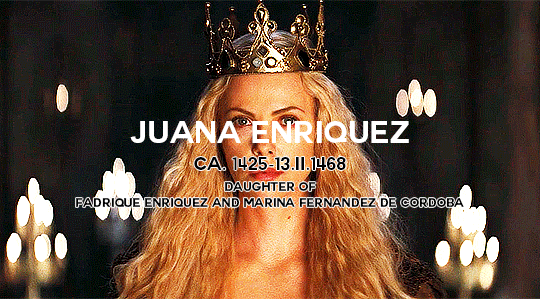


UNDERRATED RELATIONSHIP/PARTNERSHIP/FRIENDSHIP MEME 7/?: my pick: Juana Enríquez & Juan II of Aragon
The marriage of Juana Enríquez and don Juan of Aragon and Navarre was a political union, derived from a simple political expedience: the necessity to tight the bond between the adversaries of powerful don Álvaro de Luna (who, in fact, ruled in Castile), since he had gotten back in John II of Castile’s good graces. Don Diego Gómez de Sandoval, count of Castro, acted as a go-between between the admiral of Castile (Fadrique Enríquez) and the king of Navarre (Juan of Aragon). Having arranged the marriage and having obtained the consent of Alfonso V of Aragon (Juan’s older brother whom he would eventually succeed), the future spouses got betrothed – they took each other’s hands – at Torrelobatón, on 1 September 1444, in the presence of the king and queen of Castile and the prince of Asturias (future Henry IV). The bridegroom was 46, the bride 19 years old. The age difference emphasized the political nature of the union. The wedding did not take place until 1447. There were two reasons behind this delay: firstly, Rome had to be approached for the dispensation, for there existed the fourth degree of consanguinity between the betrothed, and then, the disaster of the Battle of Olmedo (1445) happened, forcing don Juan of Aragon and don Fadrique to run off to Navarre. The bride, who was already known as queen consort of Navarre, found herself in the custody of John II of Castile, who had taken over Medina de Rioseco. She recovered her liberty on 1 May 1446, thanks to the intercession of future Henry IV, but on an express condition that the wedding with her betrothed would not be celebrated without the consent of the king of Castile. The fire in the village of Atienza, which was supposed to be a part of doña Juana’s dowry, caused another delay of the admiral's matchmaking plans. Finally, John II of Castile gave the desired permission, and the young Castilian woman could receive the wedding ring from the hands of her mature, Aragonese suitor, on 13 July 1447, at Calatayud. Then, the passionate affection stirred in the heart of the Aragonese infante that he bestowed upon his second wife during their married life. According to her contemporaries, doña Juana was a beautiful, intrepid and intelligent woman. She was "charming", according to her adversary, don Pedro of Portugal, although in the pejorative sense of this word: not a charming woman but a deceitful one. It was enough to win the love of her husband. He also showed her paternal affection, for she well could be his daughter. For don Juan she always was his 'little girl’, in the moments of intimate tenderness and in those of political drama.
- Jaime Vicens Vives, Historia crítica de la vida y reinado de Fernando II de Aragón
Although he relied on his lieutenants—Carles, his wife Juana Enríquez, and later their son Fernando—he was discerning and cautious. A complex and contradictory man who was loathe to share power, Juan was infamous both for his reluctance to work with the Catalan ruling elites and his shabby treatment of his son. Carles and Juan had a deeply problematic relationship owing to the father’s unwillingness to relinquish his claim to Navarre in favor of his son, and then disinheriting him in favor of his daughter Leonor, wife of Gaston de Foix. Tensions between father and son worsened when Juan married Juana in 1444, and many of the later political problems in the Crown of Aragon can be traced to personal problems in the royal family. Juan’s miserly attitude toward the Catalans and his son did not, however, extend to his second wife. He endowed Juana with similar powers to those possessed by Maria of Castile, and in many ways she was truly co-ruler with Juan. Throughout her marriage to Juan she was one of his closest advisers and most valuable allies, traveling with him throughout Navarre and the Aragonese realms. Juan relied on her intelligence and discretion, her prodigious familial, financial, and political connections in Castile, and her tenacious and formidable negotiating skills. In 1451 he appointed her Governor of Navarre with Carles, and the next year she gave birth to Fernando, both of which further deteriorated an already troublesome relationship. In 1458 Juan appointed Carles, then thirty-three years old, as Lieutenant General in Catalunya, where he proved to be enormously popular. Juan imprisoned him on trumped up charges of treason, and when he died of tuberculosis in September 1461, accusations of foul play surfaced, accusing not only Juan but also Juana of plotting against Carles in favor of her son, Fernando (1452-1514, later Fernando II of Aragón). But Juana was nothing if not intrepid and, no newcomer to politics, she shrugged off the personal attacks and succeeded Carles as Lieutenant General. She maintained an extensive court with separate chancery and treasurer, but without the judicial and legislative offices that Maria of Castile possessed in parallel with Alfonso’s Neapolitan court. Amid the turbulence and widespread civil unrest that erupted in the wake of Carles’s death, she suppressed opposition in the towns and countryside and secured support for her husband and Fernando. In June 1461, she negotiated on behalf of the Crown to moderate the anti-royalist Capitulations of Vilafranca del Penedés. Like her sister-in-law before her, Juana sided with the remenees, a position that made her highly unpopular with the city magistrates of Barcelona and the landlords. Unlike the six Aragonese queen-lieutenants who preceded her, Juana is noted for her active involvement in military actions, notably the early campaigns of the ten-year civil war. In June 1462, she and Fernando fled from forces led by the rebellious Count of Pallars and took refuge in a royal castle in Girona only to find themselves besieged for a month. She organized the defense of the castle and held the rebels at bay until Juan and Louis XI of France arrived with military support. Although not personally at the head of an army, she was a tough negotiator who rallied and helped organize and provision an array of forces in defense of the Crown in the Ampurdán, accompanied forces to Barcelona and into Aragón. She was a key negotiator in the treaties of Sauveterre and Bayonne in May 1462 that settled the succession of Navarre and allowed the French to occupy the territories of Rousillon and Cerdanya to France in return for military support. She was virtually prisoner, with her daughter Juana, in the castle of Lárraga in 1463. Hostilities worsened, the French, Castilians, and Portuguese intervened, and periodically the Catalans ‘deposed’ (most notably in 1462) Juan, Fernando (occasionally), and Juana. Her inclusion in this list, although a dubious honor, is a clear indication of her power and importance in the political sphere. After her release from Lárraga and as the civil war intensified, she turned her attentions to governing Crown realms as Lieutenant General from 1464 until her death in 1468. With Fernando at her side, and seeking to pacify the warring factions, she presided over the Cortes of Aragón that met in Zaragoza from 1466 to 1468. During this period, she traveled extensively throughout the realms in the midst of civil war, gathering troops and supplies, negotiating with military leaders while personally attending to the business of governing—collecting taxes, holding courts of justice, dealing with the church, managing Crown lands and her own patrimony. The war outlived her by four years, but it is fitting that her indefatigable work as co-ruler with her husband and as tutor to her son mark her as the last queen-lieutenant of the Crown of Aragon.
- Theresa Earenfight, Queenship and Political Power in Medieval and Early Modern Spain
#UNDERRATED RELATIONSHIP/PARTNERSHIP/FRIENDSHIP MEME#perioddramaedit#historyedit#women in history#men in history#juana enríquez#john ii of aragon#charlize theron#robert pugh
119 notes
·
View notes
Text
12th King of Portugal (3rd of the Aviz Dynasty), King Afonso V of Portugal, “The African”
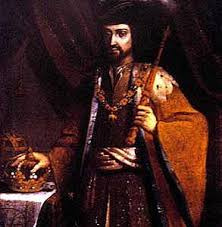
Reign: 13 September 1438 – 28 August 1481 Acclamation: 15 January 1446 Predecessor: Duarte I
Afonso V (15 January 1432 – 28 August 1481), known by the sobriquet the African (o Africano), was King of Portugal. His sobriquet refers to his conquests in Northern Africa.
As of 1471, Afonso V was the first king of Portugal to claim dominion over a plural "Kingdom of the Algarves", instead of the singular "Kingdom of the Algarve". Territories added to the Portuguese crown lands in North Africa during the 15th century came to be referred to as possessions of the Kingdom of the Algarve (now a region of southern Portugal), not the Kingdom of Portugal. The "Algarves" then were considered to be the southern Portuguese territories on both sides of the Strait of Gibraltar.

Afonso was born in Sintra, the second son of King Duarte of Portugal by his wife Leonor of Aragon. Following the death of his older brother, Infante João (1429-1433), Afonso acceded to the position of heir apparent and was made the first Prince of Portugal by his father, who sought to emulate the English Court's custom of a dynastic title that distinguished the heir apparent from the other children of the monarch. He was only six years old when he succeeded his father in 1438.
During his minority, Afonso V was placed under the regency of his mother in accordance with a will of his late father. As both a foreigner and a woman, the queen was not a popular choice for regent. Opposition rose and without any important ally among the Portuguese aristocracy other than Afonso, Count of Barcelos, the illegitimate half brother of King Duarte, the queen's position was untenable. In 1439, the Portuguese Cortes (assembly of the kingdom) decided to replace the queen with Pedro, Duke of Coimbra (Dom Pedro), the young king's oldest uncle.
Pedro's main policies were concerned with restricting the political power of the great noble houses and expanding the powers of the crown. The country prospered under his rule, but not peacefully, as his laws interfered with the ambition of powerful nobles. The count of Barcelos, a personal enemy of the Duke of Coimbra (despite being half-brothers) eventually became the king's favourite uncle and began a constant struggle for power. In 1442, the king made Afonso the first Duke of Braganza. With this title and its lands, he became the most powerful man in Portugal and one of the richest men in Europe. To secure his position as regent, Pedro had Afonso marry his daughter, Isabel of Coimbra, in 1445.
But on 9 June 1448, when the king came of age, Pedro had to surrender his power to Afonso V. The years of conspiracy by the Duke of Braganza finally came to a head. On 15 September of the same year, Afonso V nullified all the laws and edicts approved under the regency. In the following year, led by what were later discovered to be false accusations, Afonso declared Pedro a rebel and defeated his army in the Battle of Alfarrobeira,
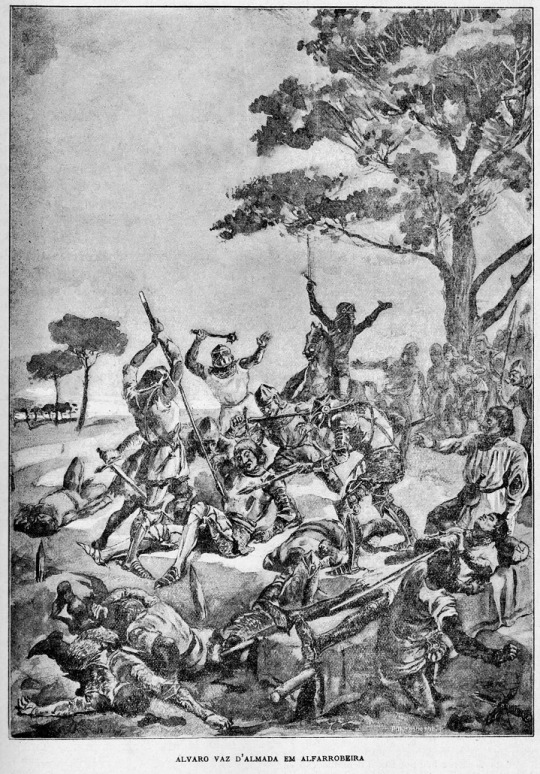
in which his uncle (and father-in-law) was killed. After this battle and the loss of one of Portugal's most remarkable infantes, the Duke of Bragança became the de facto ruler of the country.

Afonso V then turned his attentions to North Africa. In the reign of his grandfather João I, Ceuta had been conquered from the king of Morocco, and now the new king wanted to expand the conquests. The king's army conquered Alcácer Ceguer in 1458 and Arzila in 1471.
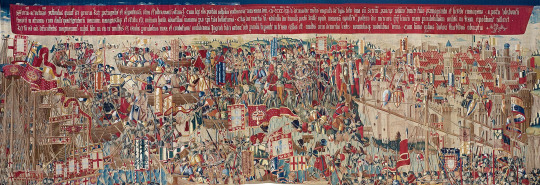
Tangiers, on the other hand, was won and lost several times between 1460 and 1464. These achievements granted the king the nickname of the African or Africano.
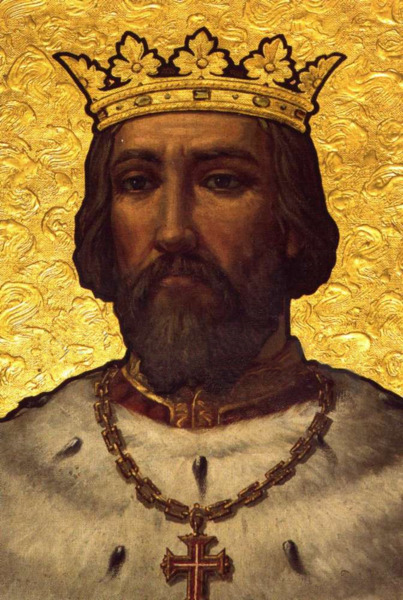
The king also supported the exploration of the Atlantic Ocean led by prince Henrique the Navigator but after Henrique's death in 1460, he did nothing to continue Henrique's work. Administratively, Afonso V was a passive king. He chose not to pursue the revision of laws or development of commerce, preferring instead to preserve the legacy of his father Duarte and grandfather João I.
In 1452, Pope Nicholas V issued the papal bull Dum Diversas, which granted Afonso V the right to reduce "Saracens, pagans and any other unbelievers" to hereditary slavery. This was reaffirmed and extended in the Romanus Pontifex bull of 1455 (also by Nicholas V). These papal bulls came to be seen by some as a justification for the subsequent era of slave trade and European colonialism.
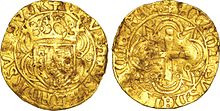
When the campaigns in Africa were over, Afonso V found new grounds for battle in neighboring Castile. On December 11, 1474 King Henry IV of Castile
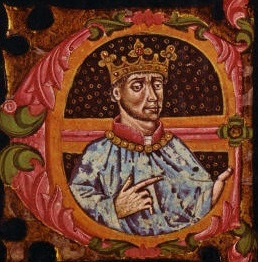
died without a male heir, leaving just one daughter, Joanna la Beltraneja.
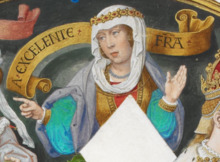
However, her paternity was questioned; it was rumored that his wife, Queen Joana of Portugal
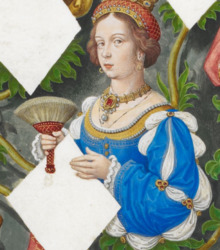
had an affair with a nobleman named Beltrán de La Cueva.
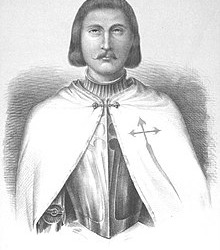
The death of Henry ignited a war of succession with one faction supporting Joana and the other supporting Isabel, Henry's half-sister.
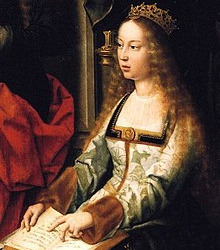
Afonso V was persuaded to intervene on behalf of Joana, his niece. He betrothed himself to her, proclaimed himself king of Castile and led troops into the kingdom. Because of their close blood-relationship, a formal marriage had to wait for papal dispensation.
On May 12, 1475, Afonso entered Castile with an army of 5,600 cavalry and 14,000 foot soldiers. In March, 1476, after several skirmishes and much maneuvering, the 8, 000 men of Afonso and Prince João,
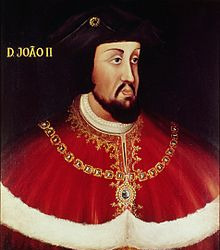
faced a Castilian force of similar size in the battle of Toro.
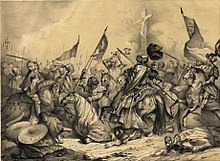
The Castilians were led by Isabella's husband, Prince Fernando II of Aragon
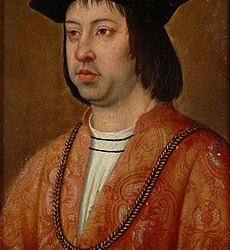
Cardinal Mendoza and the Duke of Alba. The fight was fierce and confusing but the result was a stalemate: While the forces of Cardinal Mendoza and the Duke of Alba won over their opponents led by the Portuguese King –who left the battlefield to take refuge in Castronuño, the troops commanded by Prince João defeated and persecuted the troops of the Castilian right wing, recovered the Portuguese royal standard, remaining ordered in the battlefield where they collected the fugitives of Afonso. Both sides claimed victory but Afonso's prospects for obtaining the Castilian crown were severely damaged.
“It was March 1, 1476. Eight thousand men for each side, the chronicles tell. With Afonso of Portugal were his son João and the bishops of Evora and Toledo. With Fernando of Aragón, Cardinal Mendoza and the Duke of Alba, as well as the militias of Zamora, Ciudad Rodrigo and Valladolid. The battle was long, but not especially bloody: it is estimated that the casualties of each side did not reach a thousand. Who won? In reality, no one: Afonso's wing of Portugal fell under the thrust of Fernando, but Prince João's troops crushed their Castilian rivals. However, victory in this battle was not going to be military, but ... political. In fact, Fernando of Aragon, seeing that the clash concluded without winners or losers, hastened to give his own version of the facts. He sent letters to all the cities of Castile and Aragon and to several European courts.”
After the battle, Afonso sailed to France hoping to obtain the assistance of King Louis XI
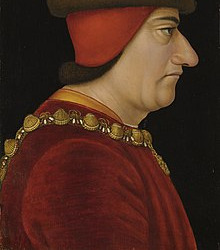
in his fight against Castile. But finding himself deceived by the French monarch, he returned to Portugal in 1477. Disillusioned, he abdicated for a few days in November 1477 in favor of his son João II, then after returning to the throne, he retired to a monastery in Sintra, where he died in 1481. He rests with his first wife Queen Isabel of Coimbra in the Founder’s Chapel, inside the Monastery of Batalha.
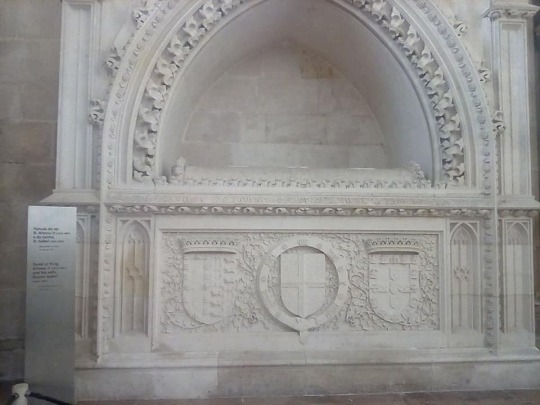
Afonso married firstly, in 1447, Isabel of Coimbra, with whom he had three children:
João, Prince of Portugal (29 January 1451). He his buried in the Unfinished Chapels in the Monastery of Batalha next to his grandparents King Duarte of Portugal and Queen Leonor de Aragão.
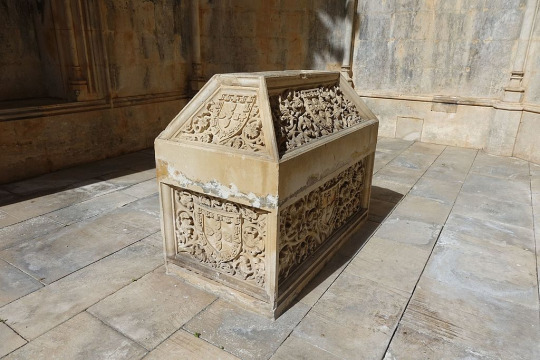
Joana, Princess of Portugal (6 February 1452 – 12 May 1490): Known as Saint Joana of Portugal or Saint Joana Princess.
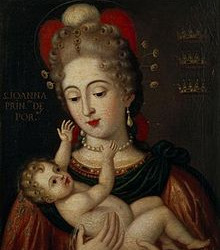
João II of Portugal (3 March 1455 – 25 October 1495): Succeeded his father as 13th King of Portugal.
Afonso married secondly, in 1475, his niece Joanna of Castile, known as "La Beltraneja".
7 notes
·
View notes
Photo

The work represents the moment when Constanza de Aragón and Entenza (1318-1346), queen of Majorca, were captured by order of her brother, King Pedro IV of Aragon. - Nicasio Serret y Comín
2 notes
·
View notes
Photo

Juan Bautista Maíno
Portrait of Fray Alonso de Santo Tomás, c. 1648-49
Museu Nacional d'Art de Catalunya, Barcelona (Inv. No. 024370-000)
THE KING’S BASTARD
Friar Alonso de Santo Tomás (1631–1692), born as Alonso Enríquez de Guzmán y de Orozco, was an illegitimate son of King Philip IV of Spain with Constanza de Ribera y Orozco, a lady-in-waiting of Queen Élisabeth of France, who was rapidly married to José Enríquez de Guzmán, gentleman-in-waiting of the King. Alonso became an orphan at the age of 3, and was raised by his adoptive father’s brother, Antonio Enríquez de Guzmán y de Porres, Bishop of Málaga and later Viceroy of Aragón.
In 1646 Baltasar Carlos, Prince of Asturias and only male heir apparent to the Spanish throne, died aged 16. Philip IV, devastated after his loss, intended to legitimize Alonso and to welcome him at court. The youth, surprisingly, refused those honors, and decided to take holy orders, becoming a Dominican friar in 1648.
Nevertheless Friar Alonso didn’t lose the royal favor of Philip IV, and by 1661 was named Bishop of Osma, two years later Bishop of Plasencia, and finally Bishop of Málaga (1664–1691). Friar Alonso was highly regarded as a theologian and orator, he published several theological essays and became a generous patron of the arts, protecting artists such as the sculptors Pedro de Mena and Alonso Cano. His portrait by Maíno was probably commissioned soon after he entered the Order, and is one of the painter’s last works.

• Details of a portrait of King Philip IV of Spain, aged 18-19 (Velázquez, c. 1623-24) & his son, Alonso de Santo Tomás, aged 17-18.
#art#painting#history#art history#portrait#juan bautista maino#baroque#baroque art#baroque painting#17th century#1640s#17th century art#spain#spanish art#spanish painting#spanish baroque art#felipe IV#philip IV#philip IV of spain#spanish monarchy#religion#catholicism
166 notes
·
View notes
Text
Petronila I de Aragón: La reina que unió Aragón y Cataluña

¿Sabías que Petronila I de Aragón fue la reina que unió los destinos de Aragón y Cataluña? Su matrimonio con el conde Ramón Berenguer IV dio origen a la Corona de Aragón, una de las potencias más influyentes de la Edad Media. Esta es su apasionante historia.
Petronila nació el 29 de junio de 1136 en Huesca, hija del rey Ramiro II el Monje y de Inés de Poitou. Su padre había abandonado su condición eclesiástica para asumir el trono tras la muerte de su hermano Alfonso I el Batallador, que no dejó descendencia. Sin embargo, Ramiro II no quería reinar, sino volver al monasterio. Por eso, cuando Petronila tenía solo un año, la comprometió con el conde de Barcelona, Ramón Berenguer IV, y le cedió todos sus derechos sobre el reino de Aragón. Así, Petronila se convirtió en la heredera de la corona aragonesa, y Ramón Berenguer en el príncipe consorte.
Petronila fue educada en la corte barcelonesa, donde aprendió las lenguas y las costumbres de su futuro esposo. El matrimonio se celebró en 1150, cuando Petronila tenía catorce años y Ramón Berenguer treinta y seis. A pesar de la diferencia de edad, se dice que se amaron y se respetaron mutuamente. Tuvieron cinco hijos: Pedro, Alfonso, Ramón, Dulce y Sancho.
Durante su matrimonio, Petronila y Ramón Berenguer gobernaron conjuntamente los territorios de Aragón y Cataluña, aunque él llevó el peso de la política y la guerra. Juntos, defendieron sus dominios de las amenazas de los reinos vecinos, especialmente de Castilla y Navarra, y expandieron sus fronteras hacia el sur, conquistando parte de Valencia y Murcia a los musulmanes.
Petronila y Ramón Berenguer también impulsaron el desarrollo cultural, económico y social de sus tierras, favoreciendo el comercio, las artes, las letras y las instituciones. Fueron protectores de monasterios, iglesias y hospitales, y promotores de la reforma gregoriana. Además, mantuvieron buenas relaciones con el papado y con otros reinos europeos, como Francia e Inglaterra.
La muerte de Ramón Berenguer en 1162 supuso un duro golpe para Petronila, que quedó viuda a los veintiséis años. Dos años después, en 1164, decidió abdicar en su hijo mayor, Alfonso, que se convirtió en el primer rey de la Corona de Aragón, con el título de Alfonso II. Petronila se retiró de la vida pública y se dedicó a la educación de sus hijos menores y a la oración. Murió en 1173, a los treinta y siete años, y fue enterrada junto a su esposo en el monasterio de Poblet.
Petronila de Aragón fue una mujer que vivió una vida extraordinaria, marcada por el amor, el poder y la fe. Su historia es una de las más importantes de la historia de España, y merece ser recordada.
#Historia#Aragón#Cataluña#MujeresEnLaHistoria#reinas
Recuerda que: Este post ha sido escrito con fines informativos y de entretenimiento. Se recomienda realizar investigaciones adicionales para obtener una visión completa de la historia de Petronila I de Aragón.
Las imágenes son solo ilustrativas no representa en si el personaje en la cual se hace mención.
0 notes
Photo

Pedro IV el Ceremonioso rey de Aragón. (1336-1387)
8 notes
·
View notes
Photo

L'ÉDUCATION DE LA VIERGE Juan Carreño de Miranda (Avilés, 25 mars 1614 - Madrid, 3 octobre 1685) est un peintre espagnol, de la cour de Philippe IV et surtout de Charles II dont il fut le plus célèbre portraitiste. ' "Ave Maria - Bruckner" sur YouTube https://youtu.be/vbHKnUhdv8g Né à Avilés dans les Asturies, il est le fils d'un peintre du même nom, Juan Carreño de Miranda. Sa famille s'installe à Madrid en 1623, où il se forme à la fin des années 1620 comme apprenti de Pedro de Las Cuevas et Bartolomé Román. Il se fait connaitre de Velázquez pour son travail dans le cloître de Doña María de Aragón et dans l'église d'El Rosario. En 1658, Carreño est embauché comme adjoint d'une commission royale pour peindre des fresques dans l'Alcázar royal de Madrid, qui sera détruit dans un incendie en 1734. En 1671, après la mort de Sébastien de Herrera, il est nommé peintre de la cour attitré à la reine (pintor de Cámara) et commence à peindre surtout des portraits. Il refuse d'être fait chevalier de l'ordre de Santiago, en disant que sa peinture n'a pas besoin d'honneurs, il peut les donner à tout le monde. Il est principalement resté célèbre comme portraitiste. Ses élèves ont été Mateo Cerezo principale, Cabezalero, Donoso, et Sotomayor Ledesma. Il meurt à Madrid. #culturejaiflash https://www.instagram.com/p/CbMopVts4_6/?utm_medium=tumblr
0 notes